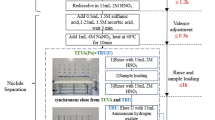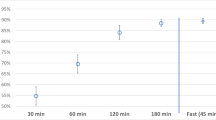Abstract
A sequential analysis procedure for urine samples was developed and validated focusing on 210Po, natural uranium, and thorium radioisotopes. The amount of sample for analysis and counting time were estimated to meet the criteria of minimum detectable activity, which was referenced from the ICRP. The analysis procedure was modified via sequential extraction and was validated using certified reference samples. The time required for sample preparation by this method was compared with those by other methods. Forty-four urine samples collected from participants were analyzed, and the results were compared with those obtained in other studies.
Similar content being viewed by others
Explore related subjects
Discover the latest articles, news and stories from top researchers in related subjects.Avoid common mistakes on your manuscript.
Introduction
Internal dosimetry of victims can be used as critical information for medical treatments pertaining to radiation emergency. Many international organizations recommend performing radiobioassays for an efficient medical treatment. In vitro techniques and analytical methods, especially using excreta samples, is an effective way of conducting the radiobioassays [1]. In case of artificial radionuclides such as plutonium and americium, the background radioactivity level in the urine samples is hardly measurable if there is no internal exposure to the radionuclides, while the uptake of naturally occurring radionuclides may occur through air and food intake [2]. The background level in these natural contaminants should be corrected in response to the radiation emergency, and this has also been suggested in previous studies [3].
Generally, alpha-emitting radionuclides such as polonium, uranium, and thorium isotopes should be extracted from raw samples by chemical treatment because of their physical characteristics [4]. Many studies have focused on enhancing the efficiency of the sample preparation time, and several analysis procedures for polonium, uranium, and thorium isotopes have been reported [5,6,7,8,9,10,11]. The conventional methods mainly focus on the single extraction technique or other types of matrix such as environmental samples. However, the pretreatment step is time-consuming, and urinalysis, in particular, has a limit on the total amount of sample owing to the difficulties in sampling from the victims.
In this study, the conventional method was improved for sequential extraction using the limited amount of urine sample, and the overall analysis procedure was reviewed and verified by focusing on 210Po, natural uranium, and thorium radioisotopes. The amount of sample and counting time were estimated following the criteria of minimum detectable activity (MDA). The analysis procedure was validated using the synthetic urine spiked with certified reference materials provided by U.S. NIST (National Institute of Standards and Technology) intercomparison program. The chemical recovery of each radionuclide was estimated to verify the effectiveness of this method. Forty-four urine samples collected from participants were analyzed. The participants were from local areas where there was no radiation work. Also, the results were compared with those obtained in other studies [16].
Experimental
Sample preparation
Urine samples were acidified with 6 M nitric acid below pH 3 for preservation, and the collected samples were concentrated by evaporation method using a hot-plate. Nitric acid and hydrogen peroxide were used to eliminate the organic matter [12]. The 210Po counting source was prepared by auto-deposition using silver disks (diameter 17.2 mm). The disk was immersed into the sample solution, and the deposition was carried out for 180 min at 90 °C [13, 14].
The sample solution is directly used for making calcium phosphate precipitation step after removing the disk. The thorium and uranium isotopes were separated by sequential extraction using TEVA (TEVA Resin, AliquatTM 336) and UTEVA (UTEVA Resin, dipentyl pentylphosphonate) (Fig. 1) The chemical recoveries of 230Th and natural uranium were corrected by the addition of 228Th and 232U, respectively [15]. The column separation was conducted using a vacuum manifold system. To obtain the counting source probes, cerium fluoride co-precipitate was deposited on a polypropylene filter (pore size 0.1 μm, diameter 25 mm). The filter was dried under an infrared lamp for 30 min and attached to a sticky plate, and subsequent radioactivity measurements were conducted for 200,000 s using alpha spectrometry (Alpha Analyst, Canberra Inc.).
Criterion for minimum detectable activity
Many expert groups have recommended the MDA derived from the reference dose as a criterion for reasonably establishing bioassays for radiation protection [16, 17]. Urine samples collected from a normal patient can be stored up to 24 h. In this study, the normalization method proposed by ICRP was adopted, using the creatinine content within 10 h of sample collection [18]. The minimum counting time was 23 h per sample, when using alpha spectrometer. The MDAs were derived based on the simplified MDA equation proposed by ANSI N13.30 [19] (1). The sb is the standard deviation of a total blank count, and t and V are counting time and sample volume, respectively.
Results and discussion
Validation
Four reference urine samples spiked with certified reference materials (CRMs) were used for validation. Urine samples were collected from normal people regardless of their exposure to radiation. The overall chemical yield ranged from 60.5 to 96.4%, and the result was in good agreement with the reference values (< ± 10%) according to ANSI N13.30 criteria [19] (Fig. 2).
Validation was performed using five reference urine samples spiked with NIST CRMs as test samples of Radiochemistry Intercomparison Program hosted by the U.S. NIST. Each synthetic urine sample was spiked with 13 alpha-emitting radionuclides (210,214,218Po, 222Rn, 226Ra, 230Th, 234,235,238U, 238,240Pu, 241Am, and 243Cm) and 12 beta- and gamma-emitting radionuclides (57,60Co, 90Sr, 90Y, 137Cs, 210,214Pb, 210,214Bi, 231,234Th, and 234mPa), and five samples were repeatedly analyzed to confirm the reproducibility of the data. The traceability and relative bias and precisions were examined as the performance criteria following ANSI N42.22 and N13.30 [19, 20]. The results for natural uranium, 230Th, and 210Po were within the range of reference values (Table 1).
Study of the background level
Previous studies have reported that the background level of several radionuclides in the human body was dependent on the exposure to terrestrial radiation by naturally occurring radionuclides [5,6,7,8,9,10,11]. To investigate this, some projects were carried out to survey the background level in urine samples. In this study, forty-four urine samples collected from normal people dwelling in five local areas were analyzed. Each sampling site was specifically selected considering the lifestyles and environment, such as metropolis with over million residents, inland cities, mountainous districts, and coastal areas (Table 2 and Fig. 3).
The radioactivities of 238U, 234U, 230Th, and 210Po were 8.34, 10.8, 6.06, and 22.5 mBq/d, respectively. The ratio of 238U and 234U were relatively different from the general natural uranium ratio due to the variaction of total values. The coefficients of variation for 238U and 234U were 17% and 24%, respectively. The overall data were similar to those of the previous studies reported from other countries. Moreover, the background levels did not differ significantly with the sampling site, suggesting that Koreans normally consume processed foodstuffs and agricultural and marine products distributed by well-organized logistics. The lifestyle and dwelling condition of the participants were also similar despite the different sampling area following questionnaires. The radioactivity of 210Po was slightly higher than the other radionuclides, and this observation was similar to that in other studies [8, 21, 22] (Tables 3 and 4).
The comparison of the radioactivities of 238U and 210Po showed slightly different trends, which was not affected by the decay series. The results showed that the background levels of naturally occurring radionuclides in the human body were not dominated by the decay series but mainly originated from the inhabiting environment [10] (Fig. 4).
Conclusions
In this study, a sequential method for the analysis of 210Po, natural uranium, and thorium radioisotopes in urine samples is developed and validated. The procedure was applied to measure the background levels in urine samples collected from normal people. The total counting time was assessed to meet the MDA criteria. In the future, trace element detection techniques need to be applied to the sequential procedure to reduce the measurement time.
References
International Atomic Energy Agency (2005) Generic procedures for medical response during a nuclear or radiological emergency. Austria, Vienna
United Nations Scientific Committee on the Effects of Atomic Radiation (2000) Sources and effects of ionizing radiation. United Nations, New York
International Commission on Radiological Protection (1997) Individual Monitoring for Internal Exposure of Workers, Oxford
Lehto J, Hou X (2010) Chemistry and analysis of radionuclides. Wiley, Weinheim
Al-Arifi M, Alkarfy K, Al-Suwayeh S, Aleissa K, Shabana E, Al-Dhuwaili A, Al-Hassan M (2006) Levels of 210Po in blood, urine and hair of some Saudi smokers. J Radioanal Nucl Chem 269:115–118
Dang HS, Pullat VR, Pillai KC (1992) Determining the normal concentration of uranium in urine and application of the data to its biokinetics. Health Phys 62:562–566
Malátová I, Bečková V, Tomášek L, Hůlka J (2011) Content of uranium in urine of uranium miners as a tool for estimation of intakes of long-lived alpha radionuclides. Radiat Prot Dosim 147:593–599
Naumann M, Hänisch K, Hartmann M (1998) Levels of natural radionuclides in human excreta in the Berlin area. Radiat Prot Dosim 79:197–200
Oeh U, Priest ND, Roth P, Ragnarsdottir KV, Li WB, Hollriegl V, Thirlwall MF, Michalke B, Giussani A, Schramel P, Paretzke HG (2007) Measurements of daily urinary uranium excretion in German peacekeeping personnel and residents of the Kosovo region to assess potential intakes of depleted uranium (DU). Sci Total Environ 381:77–87
Santos P, Gouvea R, Dutra I (1994) Concentrations of 210Pb and 210Po in hair and urine of workers of the uranium mine at Poços de Caldas (Brazil). Sci Total Environ 148:61–65
Schäfer I, Seitz G, Hartmann M (2006) Investigations of excretion rates of the radionuclides 230Th, 226Ra, 210Pb and 210Po of the general population and of workers in selected regions in Germany. European IRPA congress on radiation protection
Eichrom Technologies I (2006) Analytical procedures-americium, neptunium, plutonium, thorium, curium, uranium, and strontium in water (with vacuum box system). Eichrom Technologies, Inc
Lee M, Lee C, Song K, Kim C, Martin P (2010) Determination of polonium nuclides in a water sample with solvent extraction method. Bull Korean Chem Soc 31:2488–2492
Matthews KM, Kim C-K, Martin P (2007) Determination of 210Po in environmental materials: a review of analytical methodology. Appl Radiat Isot 65:267–279
Martin P, Hancock G (2004) Routine analysis of naturally occurring radionuclides in environmental samples by alpha-particle spectrometry. Australian Government Publishing Service, Australia
Castellani CM (2013) IDEAS Guidelines (Version 2) for the estimation of committed doses from incorporation monitoring data. EURADOS-2013-01
International Commission on Radiological Protection (2012) Occupational intakes of radionuclides Part 2, Oxford
International Commission on Radiological Protection (1975) Report of the task group on reference man. Publication 23, Oxford
ANSI (2011) Performance criteria for radiobioassay, Standard N13.30. American National Standard Institute
ANSI (1995) Traceability of radioactive sources to the National Institute of Standards and Technology (NIST) and associated instrument quality control, Standard N14.22. American National Standard Institute
Okabayashi H (1982) A study on the excretion of Pb-210 and Po-210. J Radiat Res 23:242–252
Lipsztein J, Melo D, Sousa W, da Cunha KD, Azeredo A, Julião L, Santos M (2003) Norm workers: a challenge for internal dosimetry programmes. Radiat Prot Dosim 105:317–320
Acknowledgements
This study was supported by a grant from the Korea Institute of Radiological and Medical Sciences (KIRAMS), funded by the Ministry of Science and ICT (MSIT), Republic of Korea. (No. 50535-2019).
Author information
Authors and Affiliations
Corresponding author
Additional information
Publisher's Note
Springer Nature remains neutral with regard to jurisdictional claims in published maps and institutional affiliations.
Rights and permissions
About this article
Cite this article
Yoon, S., Kim, Y., Ha, WH. et al. Improved urine analysis for polonium, natural uranium, and thorium isotopes and background survey in collected samples of normal people. J Radioanal Nucl Chem 322, 1871–1875 (2019). https://doi.org/10.1007/s10967-019-06822-0
Received:
Published:
Issue Date:
DOI: https://doi.org/10.1007/s10967-019-06822-0








